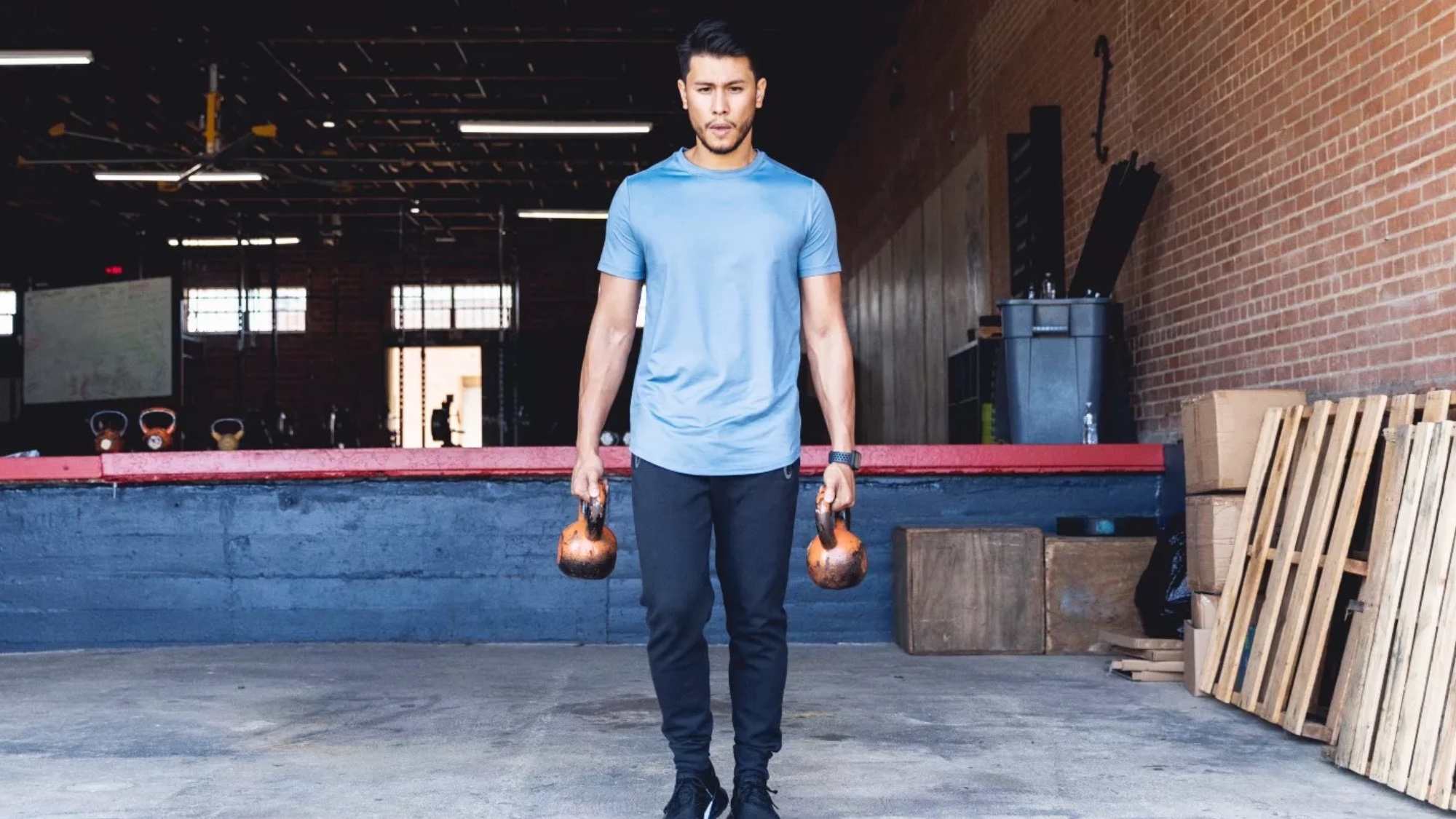
Alongside a farmer’s walk, the farmer’s hold is one of the best shoulder exercises for strengthening the muscles in your shoulders, arms, back, and core muscles without actually moving. The move can be done anywhere and at any time.
To do a farmer’s hold, you can pick up a trap bar or two heavy weights like kettlebells or dumbbells (I like to work out with the best adjustable dumbbells) and simply stand there, waiting for the time to pass. Couldn’t be simpler, right?
Now, I want you to imagine holding two heavy bags containing your entire week's worth of groceries, then standing in a long queue without putting those bags down. It’s no one's idea of fun, so I sadistically decided to do it every day for a week (as you do). Granted, I was standing in my apartment rather than in a queue, staring pleadingly at my dog, but I can confirm it didn’t make things easier. Here’s what happened.
If you have a shoulder injury, check with a personal trainer or qualified medical professional before trying this exercise or any new workout. Stop if you experience pain or any existing pain worsens.
How to do the farmer’s hold
For beginners, try using light weights first before adding heavier weights as your shoulders and core muscles adjust.
- Stand with your feet hip-width apart and two weights placed on either side of your feet
- Bend your knees and lower into a squat position with your chest proud, back flat, and weight evenly distributed across your feet
- Grip both weights, engage your core and set your shoulders back and down
- Keep your chest proud, look forward, and push the ground away to stand. Hold.
Farmer's hold benefits
The farmer's hold move develops grip strength and the muscles in your forearms, arms, shoulders, core, and upper trapezius (at the top of your back). Under heavier loads, your chest muscles will also switch on. The farmer’s hold is an isometric exercise to be reckoned with.
The term ‘isometric’ means that your muscles are held under contraction without lengthening or shortening. Without flexing or extending your muscles, strength gains are up for grabs. And alongside a strength training program — shoulders even Arnie would be proud to have.
Sign up to get the BEST of Tom's Guide direct to your inbox.
Get instant access to breaking news, the hottest reviews, great deals and helpful tips.
The move also challenges your balance and core stability. During the exercise, your shoulders are held under constant tension, challenging postural stability and control.
I did the farmer's hold every day for a week — here’s my results
You can be cruel with this exercise, switching out weights with handles for barbell plates that are harder to grip. As I was in charge, I chose dumbbells.
Day 1
I did the farmer’s walk every day for a week, but at least walking keeps your mind busy, This variation involves trying to think of anything except your fatiguing arms and shoulders.
I was familiar with the move going in, as I’ve tackled it during CrossFit workouts, which probably made it worse. However, unlike my approach, it’s often programmed in strength and conditioning alongside isotonic exercises (like lunges or pull-ups). For example, you might rotate between a set of calories on the rower and a farmer’s hold, perhaps swapping with a partner.
I opted for 45 seconds on and 15 seconds off for five rounds, rested for a few minutes, then back in for five more rounds. I noticed that my grip was slipping after the first few rounds, so decided to add liquid chalk to improve things.
Days 2 and 3
Although your focus is mostly on your arms not dropping off, it’s not just your biceps, triceps, and shoulder complex working. The move also targets the core muscles in your trunk, including the rectus abdominis, oblique muscles and deeper core muscles like the erector spinae in your back.
I focused on active ab engagement throughout the exercise and was surprised to feel it in my stomach over the following few days. On the third day, I could feel my left shoulder and lower back tweaking, so I decided to drop down in weight slightly to protect my shoulder and focused on core engagement and tall posture.
Days 4 and 5
Your breath is crucial when you exercise, and holding your breath could put a strain on your heart and limit the oxygen available to your muscles. I always encourage belly breathing — expansive breathing into your diaphragm and back — rather than restrictive chest breathing.
Deep breathing also helps regulate your nervous system, which calms your body down. Rhythmic breathing became almost meditative and helped me take my mind off the growing tremble in my arms and core and back to my breath, allowing me to count and breathe the 45 seconds away with more control and focus.
Day 6
By this point, my shoulders were fatiguing, and I noticed some rounding forward. My left shoulder has always been problematic, but I know how to manage it safely. If you have a mirror, I strongly suggest performing exercises in front of one to keep an eye on strong form.
Undetected, poor posture during this exercise could result in back injuries and weakening in your rotator cuff muscles — the stabilizing shoulder muscles. When I noticed my shoulders shift forward, I rolled them back, gently untucked my pelvis, and reengaged my core. I immediately felt taller and less strained in my back, although it sent focus straight back to my aching shoulders!
Day 7
By the end of the week, I was glad it was all over but learned a lot. My grip still needs work, and even liquid chalk couldn’t stop me from resetting the weights sometimes for a quick breather (when the dog wasn’t watching). I also body scanned every 10 seconds to check form.
Verdict
In day-to-day life, I don’t encourage clients to work their shoulders every day in this way. Remember that muscle growth comes from repair and rest after the workout, which can’t happen properly without factoring in rest and active recovery.
Your rotator cuff muscles surround the shoulder joint and stabilize and support it through movement. Persistent, poor posture could lead to weak stabilizing muscles that won’t properly support your primary working muscles.
If this sounds familiar, add these 5 shoulder stretches for tight shoulders to your recovery routine. And to develop grip strength, practice how to deadlift, or hang from a pull-up bar to improve wrist and shoulder strength.
More from Tom's Guide

Sam Hopes is a level 3 qualified trainer, level 2 reiki practitioner and senior fitness writer at Tom's Guide. She is also currently undertaking her Yoga For Athletes training course. Sam has written for various fitness brands and websites over the years and has experience across brands at Future such as Live Science, Fit&Well, Coach, and T3.
Having worked with fitness studios like F45 and Virgin Active, Sam now primarily teaches outdoor bootcamps, bodyweight, calisthenics and kettlebells. She also coaches mobility and stretching-focused classes several times a week and believes that true strength comes from a holistic approach to training your body.
Sam has completed two mixed doubles Hyrox competitions in London and the Netherlands and finished her first doubles attempt in 1:11.

